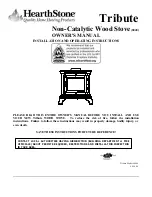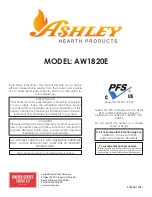
HearthStone
Quality Home Heating Products Inc
®
Tribute Model 8040
12
Install the stove as close as practical to the chimney,
while maintaining all proper clearances. Install stovepipe
that is as short and as straight as possible. Horizontal runs
of stovepipe should always rise away from the stove a
minimum of 1/4" per foot (21mm/m).
Long runs of stovepipe to increase heat dispersal are not
recommended
. Using longer lengths of stovepipe or more
connecting elbows than necessary increase the chances of
draft resistance and the accumulation of creosote buildup.
In general, you do not need to install a stovepipe damper
with the Tribute. Some installations, however, could
benefit from a stovepipe damper, such as a tall chimney
which can create a higher than normal draft. In such
cases, a damper can help regulate the draft. The Tribute
requires a draft between 0.06" wc and 0.1" wc. For drafts
above 0.1" wc, install a stovepipe damper. This should be
checked at installation time.
Remember, the NFPA has recommended, minimum
clearances for chimney connectors to combustibles such
as walls and ceilings. Once the stove is installed at safe
distances from these combustible surfaces, it is important
to maintain these connector clearances for the remainder
of the installation.
C
ONNECTING
Y
OUR
W
OOD
S
TOVE
You can install your Tribute to a prefabricated metal
chimney or a masonry chimney.
Connecting to a Prefabricated Metal Chimney
There are two ways to install a prefabricated metal
chimney:
•
An
interior
installation where the chimney passes
inside the residence through the ceiling and roof.
•
An
exterior
installation where the chimney passes
through the wall behind the stove then up the outside
of the residence.
Whenever possible, choose an interior chimney. An
interior chimney heats up more quickly and retains its
heat; thus promotes a better draft and discourages the
formation of creosote. An exterior chimney does not
benefit from the warmth of being surrounded by the
building, so it typically operates at lower flue
temperatures than an interior chimney. An exterior
chimney’s draft is not as strong and may experience
increased creosote accumulation.
When connecting the Tribute to a prefabricated metal
chimney, you must follow, precisely, the manufacturer's
installation instructions. Use only Type HT (2100 deg.
F), prefabricated metal chimneys listed per UL 103 or
ULC S629 standards.
¦
WARNING:
DO NOT CONNECT THE STOVE TO A
CHIMNEY FLUE SERVING ANOTHER
APPLIANCE.
Make sure the size of the chimney’s flue is appropriate for
the Tribute. The Tribute requires a 6" (152 mm) inside
diameter flue for new installations. A 6” diameter flue
provides adequate draft and performance. You can use an
8" (203 mm) diameter existing flue with a reducer. An
oversized flue contributes to creosote accumulation. (In
this case, bigger is NOT better.)
When purchasing a prefabricated chimney to install with
your stove, be sure to also purchase from the same
manufacturer the wall pass-through (or ceiling support
package), "T" section package, fire-stops (when needed),
insulation shield, roof flashing, chimney cap, and any
other needed accessories. Follow the manufacturer’s
instructions when installing the chimney and accessories.
In addition, be sure to maintain all manufacturers’
recommendations for the proper clearances to the
chimney.
C
ONNECTION
T
O
A M
ASONRY
C
HIMNEY
Consider two primary elements when connecting your
stove to a masonry chimney: the chimney itself and the
thimble where the stovepipe connects to the chimney.
Use only Code approved masonry chimneys with a flue
liner.
Before connecting to a masonry chimney, hire a
professional to examine the chimney for cracks, loose
mortar, and other signs of deterioration and blockage. If
the chimney needs repair, complete them before installing
and using your stove. Do not install your stove until the
chimney is safe for use.














































